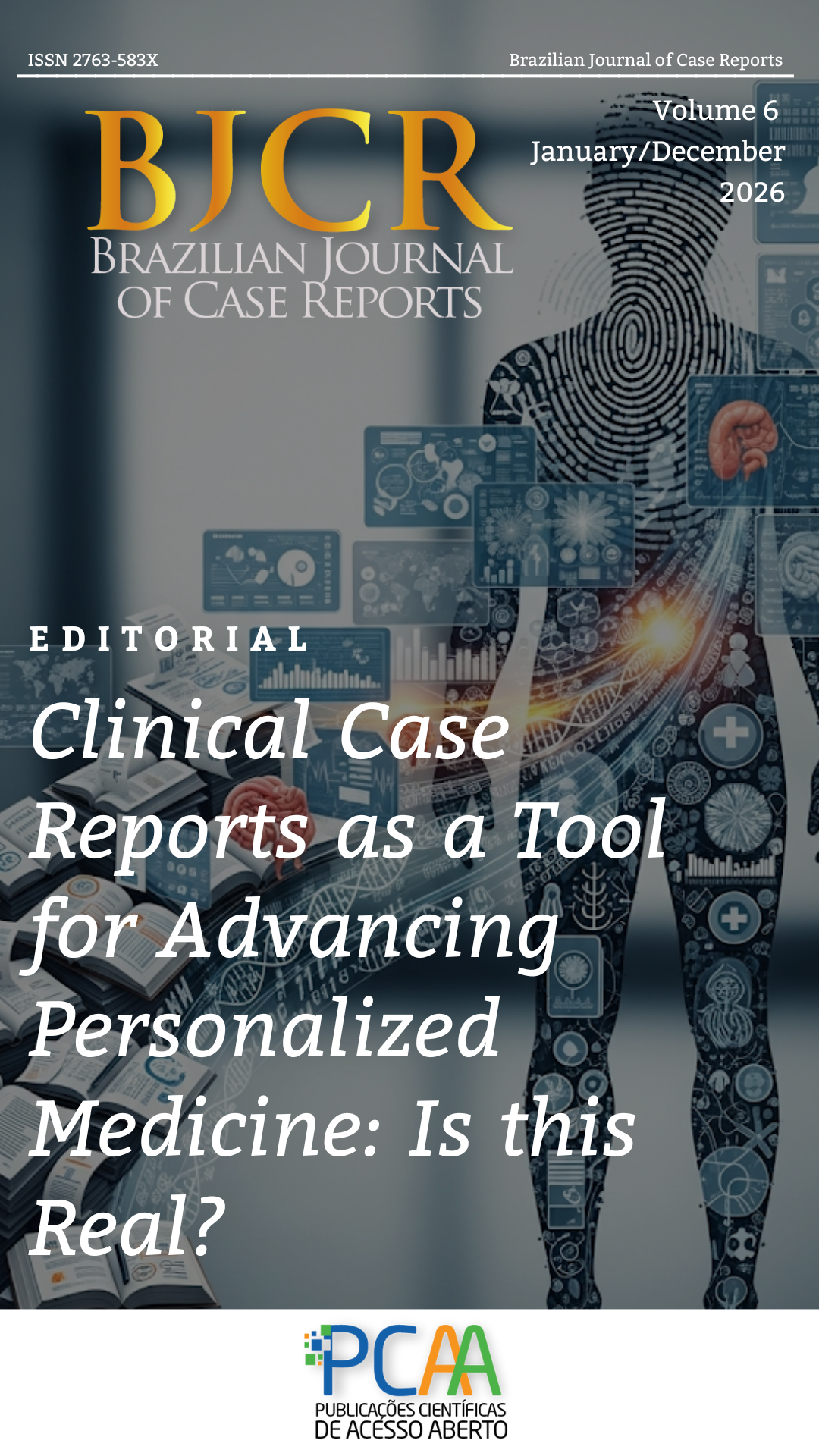Case Report of Subclavian Artery Injury After Reduction of Right Shoulder Dislocation
Main Article Content
Abstract
Shoulder dislocations are common in emergency settings; however, associated vascular injuries are rare, occurring in approximately 1–2% of cases. Among these, axillary and subclavian artery damage is particularly serious, with high morbidity and potential limb loss if not promptly recognized. We report the case of a 79-year-old male, hypertensive and dyslipidemic, who sustained a ground-level fall with right glenohumeral dislocation. Following an attempted closed reduction without sedation, he developed ischemic signs and an expanding hematoma. Initial workup with non-contrast tomography and bedside ultrasound suggested subclavian artery thrombosis. During brachial artery embolectomy, a complete subclavian artery rupture with a 7 cm gap was identified, requiring open repair with a 6 mm Dacron® graft. Postoperatively, the patient developed significant motor deficits of the right upper limb, confirmed by MRI and electromyography as brachial plexus injury. He was discharged on anticoagulation and remains under follow-up with partial functional recovery. This case highlights the importance of systematic neurovascular examination in shoulder dislocation, especially in elderly patients with comorbidities, as collateral circulation may mask early ischemia. Early use of contrast imaging and standardized emergency protocols are critical to improving outcomes. Although rare, subclavian artery injury during shoulder reduction must always be considered, requiring immediate diagnosis and intervention to preserve limb viability and function.
Article Details

This work is licensed under a Creative Commons Attribution 4.0 International License.
Authors retain the copyright of their articles and grant the journal the right of first publication under the Creative Commons Attribution (CC BY) license, which allows others to share and adapt the work with proper attribution.
References
Zacchilli MA, Owens BD. Epidemiology of shoulder dislocations presenting to emergency departments in the United States. Journal of Bone and Joint Surgery [Internet] 2010 [cited 2025 Apr 29];92(3):542–9. Available from: https://pubmed.ncbi.nlm.nih.gov/20194311/.
Perron AD, Ingerski MS, Brady WJ, Erling BF, Ullman EA. Acute complications associated with shoulder dislocation at an academic Emergency Department. Journal of Emergency Medicine [Internet] 2003 [cited 2025 Apr 29];24(2):141–5. Available from: https://pubmed.ncbi.nlm.nih.gov/12609642/.
Cutts S, Prempeh M, Drew S. Anterior shoulder dislocation. Ann R Coll Surg Engl2009;91(1).
Nakada T aki, Idoguchi K, Fukuma H, Ono H, Nakao S, Matsuoka T. Case Report: Urgent endovascular treatment of subclavian artery injury after blunt trauma. F1000Res [Internet] 2014 [cited 2025 Apr 29];3. Available from: https://pubmed.ncbi.nlm.nih.gov/25717371/.
Magister S, Bridgforth A, Yarboro S. Axillary Artery Injury Following Closed Reduction of an Age-Indeterminate Anterior Glenohumeral Dislocation. J Orthop Case Rep [Internet] 2018 [cited 2025 May 5];8(4):53–6. Available from: https://pubmed.ncbi.nlm.nih.gov/30687664/.
Patousis A, Sachinis NP, Yiannakopoulos C, Givissis P. Axillary Artery Injury and By-Pass Restoration After Open Reduction of a Chronic Shoulder Dislocation: A Case Report. Cureus [Internet] 2022 [cited 2025 May 5];14(3). Available from: https://pubmed.ncbi.nlm.nih.gov/35505720/.
Li Z, Zhao L, Wang K, Cheng J, Zhao Y, Ren W. Characteristics and treatment of vascular injuries: a review of 387 cases at a Chinese center. Int J Clin Exp Med [Internet] 2014 [cited 2025 May 5];7(12):4710. Available from: https://pmc.ncbi.nlm.nih.gov/articles/PMC4307415/.
Eyler Y, Yılmaz Kilic T, Turgut A, Hakoglu O, Idil H. Axillary artery laceration after anterior shoulder dislocation reduction. Turk J Emerg Med [Internet] 2019 [cited 2025 May 5];19(2):87–9. Available from: https://pubmed.ncbi.nlm.nih.gov/31073545/.
Rodrigues R, Moura D, Agostinho AG, Fonseca M. Endovascular Treatment Of An Axillary Arterial Injury Following A Traumatic Shoulder Dislocation: Case Report. Angiologia e Cirurgia Vascular [Internet] 2022 [cited 2025 May 5];17(4):330–3. Available from: https://acvjournal.com/index.php/acv/article/view/459.
Kelley SP, Hinsche AF, Hossain JFM. Axillary artery transection following anterior shoulder dislocation: Classical presen-tation and current concepts. Injury [Internet] 2004 [cited 2025 May 5];35(11):1128–32. Available from: https://pubmed.ncbi.nlm.nih.gov/15488503/.
Olds M, Ellis R, Donaldson K, Parmar P, Kersten P. Risk factors which predispose first-time traumatic anterior shoulder dislocations to recurrent instability in adults: A systematic review and meta-analysis. Br J Sports Med [Internet] 2015 [cited 2025 May 5];49(14):913–22. Available from: https://pubmed.ncbi.nlm.nih.gov/25900943/.
Thorsness R, English C, Gross J, Tyler W, Voloshin I, Gorczyca J. Proximal humerus fractures with associated axillary artery injury. J Orthop Trauma [Internet] 2014 [cited 2025 May 5];28(11):659–63. Available from: https://pubmed.ncbi.nlm.nih.gov/24682164/.
Tomaszek DE. Combined subclavian artery and brachial plexus injuries from blunt upper-extremity trauma. Journal of Trauma - Injury, Infection and Critical Care [Internet] 1984 [cited 2025 May 5];24(2):161–3. Available from: https://pubmed.ncbi.nlm.nih.gov/6694242/.
Tian X, Liu JL, Jia W, Jiang P, Cheng ZY, Zhang YX, et al. Comparison of traditional vascular reconstruction with covered stent in the treatment of subclavian artery injury. Chinese Journal of Traumatology - English Edition [Internet] 2020 [cited 2025 May 5];23(1):25–8. Available from: https://pubmed.ncbi.nlm.nih.gov/32057562/.
Sasson M, Montorfano L, Bordes SJ, Sarmiento Cobos M, Grove M. Subclavian Artery Injury Following Central Venous Catheter Placement. Cureus [Internet] 2021 [cited 2025 May 5];13(4). Available from: https://pubmed.ncbi.nlm.nih.gov/33968501/.
Elkbuli A, Kinslow K, Dowd B, McKenney M, Boneva D, Whitehead J. Subclavian artery injury secondary to blunt trauma successfully managed by median sternotomy with supraclavicular extension: A case report and literature review. Annals of Medicine and Surgery [Internet] 2020 [cited 2025 May 5];54:16–21. Available from: https://pubmed.ncbi.nlm.nih.gov/32322390/.
Danetz JS, Cassano AD, Stoner MC, Ivatury RR, Levy MM. Feasibility of endovascular repair in penetrating axillosubclavian injuries: A retrospective review. J Vasc Surg [Internet] 2005 [cited 2025 May 5];41(2):246–54. Available from: https://pubmed.ncbi.nlm.nih.gov/15768006/.
Barmparessos E, Katsikas V, Gravanis M, Kalamaras A, Kopadis G. Combination of endovascular and open repair for the management of subclavian artery injury. Trauma Case Rep [Internet] 2022 [cited 2025 May 5];41. Available from: https://pubmed.ncbi.nlm.nih.gov/35844963/.
